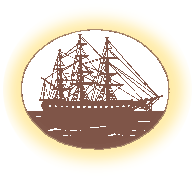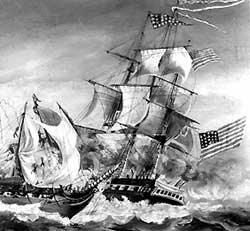
 |
 |
| Getting Started Key Words & Concepts Glossary Activities Recommended Resources Scuttlebutt | ||||
Getting Started  To help students understand the position of the United States in the early 1800s, use a personal comparison. Ask them if they have ever been pressured to take sides in a dispute that did not directly involve them. Did they stay out of it or did they get involved? Did they try to help resolve the problem? Was it hard for them to avoid the difficulty? What are the advantages and disadvantages of getting involved? Of staying neutral? Of taking sides? | ||||
Key Words and Concepts
With student input, make a list on the board of the pluses and minuses of each option for responding to someone else’s dispute. Now describe the position of the United States vis-à-vis England and France in the opening decade of the 19th century.
Napoleon’s army was marching across Europe, conquering everything in its path. England was the last holdout. Although Napoleon was clearly the aggressor, America felt a loyalty to France because of her support in our war of independence from England. Ask students to examine the neutral position. What happens when you try to remain friendly with two people who are fighting with each other?
With trade suspended between the warring countries, neutral America had a commercial advantage: her merchants could supply both sides. By 1805, England and France were trying to blockade one another by intercepting American merchant ships bound for the enemy. Not only were the warring countries diverting cargo, they were impressing, or kidnapping, American sailors. French and English press gangs boarded American merchant ships and seized crew members to fill the shortage of seamen needed to fight their battles with each other. England pressed thousands of U.S. sailors into service until America reached the boiling point. Congress declared war on England June 18, 1812, in the name of free trade and sailors’ rights.
The War of 1812 was not a popular war. Much of America was focused on the country’s westward expansion. Besides, the British were far superior in naval power, and our crews lacked experience, especially when compared to the English seamen who had been fighting the French for 20 years. We had to suffer boasts like the following delivered to an American commodore at the outbreak of war: “Captain James Dacres, commander of His Britannic Majesty’s frigate Guerriere ... will be very happy to meet ... any ... American frigate ... for the purpose of having a few minutes tête-`a-tête.
Two months after war was declared, under this cloud of national division and a sense of inferiority, Constitution sailed into her most famous battle.
 |
| Constitution and Guerriere Thomas Magoun, 1835 Courtesy USS Constitution Museum, Boston |
On August 19, 1812, in heavy seas 300 miles east of Halifax, Nova Scotia, Constitution had that “tête-`a-tête” with Dacres and Guerriere, one of the most reviled ships of the Royal Navy for her seizure of so many American sailors and for her role in the blockade of New York. Commanded by Captain Isaac Hull, who had served under Commodore Preble in the Barbary Wars, Constitution approached Guerriere, holding her fire until she was along side. Then Constitution’s crew let loose a furious broadside.
At the height of battle, a sailor saw shot bounce off Constitution’s topsides and cried, “Huzzah! Her sides are made of iron!” Thus her famous nickname was born. To give students a sense of the aftermath of the battle, read aloud the dramatic and poetic eyewitness account of the sinking of Guerriere on the activities pages. Constitution sailed home to riotous victory celebrations in
her honor.
Just before the war ended, Constitution slipped through the blockade off Boston and set out in pursuit of British warships in what turned out to be her last battle. On February 20, 1815, she found her British quarry off the island of Madeira. Under the command of Captain Charles Stewart, Constitution defeated the British warships Cyane (SY-AN) and Levant in a sunset battle by maneuvering them apart and defeating them individually. But like the more famous Battle of New Orleans, which had recently taken place, Stewart’s victory was a bit of an historical accident. The Treaty of Ghent, which ended the War of 1812, was ratified by Congress three days before Constitution’s stunning victory.
- neutral: not for or against
- impressing: forcing into service
- broadside: the whole discharge of all guns on one side of a ship
- topsides: the sides of a vessel above the waterline
| K-4
5-8
9-12
|
 |
